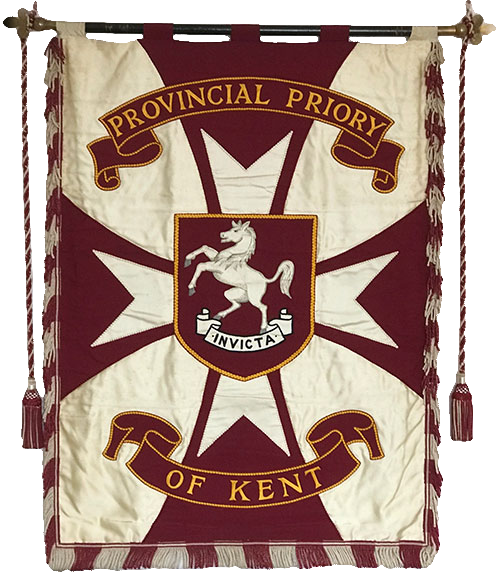 The United Religious, Military and Masonic Orders of the Temple and of St John of Jerusalem, Palestine, Rhodes and Malta in England and Wales and Provinces Overseas
The United Religious, Military and Masonic Orders of the Temple and of St John of Jerusalem, Palestine, Rhodes and Malta in England and Wales and Provinces OverseasProvince of Kent
 Explanation of the Provincial Banner
Explanation of the Provincial BannerThe Banner was created and Dedicated in 1956 when Kent and Surrey Provincial Priory spilt from each other, the first Provincial Prior to be presented with the Provincial Banner was Captain Alexander McKenzie-Smith.
 The word Banner in classical Latin language is Vexillum meaning a Rag consisting of a piece of cloth fixed on a frame, cross-tree or little sail. The Banner represents the sails used by the Knights Templar on their Cogs or Galleons, sailing to the holy land. It consists of a maroon Knights Templar Cross Pattee on a pure white background. These types of crosses were blazon on the Knights Templar Mantles and on Crusaders breasts, who took up the cross following Pope Uban ll rallying sermon calling for the faithful to liberate the Holy Land. "Saying you shall wear the sign of the cross of the Lord on your breast".
The word Banner in classical Latin language is Vexillum meaning a Rag consisting of a piece of cloth fixed on a frame, cross-tree or little sail. The Banner represents the sails used by the Knights Templar on their Cogs or Galleons, sailing to the holy land. It consists of a maroon Knights Templar Cross Pattee on a pure white background. These types of crosses were blazon on the Knights Templar Mantles and on Crusaders breasts, who took up the cross following Pope Uban ll rallying sermon calling for the faithful to liberate the Holy Land. "Saying you shall wear the sign of the cross of the Lord on your breast".The background of the Banner is called the field, and is usually composed of one or more tinctures of colour or furs. This field is mounted by a Maroon Knight Templar Pattee cross which is superimposed with a white eight pointed Cross of the order of St John of Jerusalem Palestine Rhodes and Malta. The eight points represent the eight languages or tongues of the order of the Knights of Malta.
On top of which is the shield of Kent, consisting of a prancing white horse on a maroon field background edged with gold braiding cord and a white scrolled vector or ribbon embroidered with the word INVICTA. This is the well known motto of the County of Kent INVICTA is a Latin word meaning undefeated or unconquered. The white horse of Kent is the old symbol for the Jutish Kingdom of Kent, dating from the 6th–8th century. The white horse relates to the emblem of Horsa, the brother of Hengest, who according to legend defeated the King Vortigern near Aylesford Kent. The heraldic image is correctly blazoned as Gules, a Stallion forcené argent. Gules meaning red background, Stallion a male horse, forcené meaning prancing or holding position, argent meaning white or silver.
The Banner is edged with a maroon and white fringe which originally allowed the banner to shed rain and to dry faster when wet because the fringe acted as a series of wicks to disperse the water. This is now used as a very decorative feature. The Banner is hung on a cross pole capped with brass finials. Finials are the ornament at the top, end, or corner of an object. Theses finials are tied with draping tassels in maroon and white. The tassel is a tuft of loosely hanging threads or cords knotted at one end and attached for the decoration of soft furnishings and banners.
Photograph taken by E.Kt. Andy Waters Provincial Banner Bearer.
< back